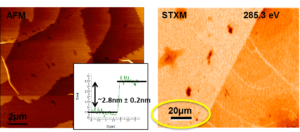Manuel Johnson
Manuel Johnson, M.Sc.
Project description
Over the last two decades the scientific interest in organic thin films and their potential applications in molecule-based electronics has steeply increased. It has been found that the charge transport in organic electronic devices like organic field-effect transistors (OFETs) crucially depends on the structural properties of the prepared films [1]. Since vacuum sublimation induces polycrystalline film growth, this leads to an upper performance limit of thus prepared devices.
Within this project a solution-based route for the preparation of long-range ordered and single-crystalline organic thin films is explored [2]. In this method, the self-organization of molecules (specifically suited for molecular electronics applications) with sufficiently strong ππ-interaction at the liquid-liquid interface is used. The liquid surrounding offers better chance for molecular diffusion and self-organization and consequently the near-equilibrium growth of crystalline organic films with lateral extensions in the range of 1 millimeter. The film preparation follows the sequence depicted in Fig. 1, that includes the film transfer onto solid substrates. Resulting films were analyzed by AFM and STXM (Fig. 2).
The focus of this research project will be lying on the optimization of the film growth parameters, film transfer and the test of the deposited films with respect to their charge transport behavior in OFETs. Emphasis will be lying on in-situ techniques to explore the molecular self-organization at the liquid-liquid interface, nucleation and growth kinetics using GI-SAXS and GI-WAXS. Organic electronic devices based on thus prepared films shall be investigated by spatially resolving electron spectroscopic tools (STXM, XPEEM, UV-PEEM) to observe the electronic structure within the semiconducting channel of an OFET. Kelvin-probe force microscopy (in collaboration with B1) will offer complementary insight into charge transport. Vacuum-sublimated films shall be explored as reference.

Fig. 1: Schematic procedure of self-assembled thin film growth at the liquid-liquid interface.
 Fig. 2: AFM (left) and STXM (right) image of self-assembled thin films.
Fig. 2: AFM (left) and STXM (right) image of self-assembled thin films.
References
[1] M. Halik et al., Adv. Mat. 15 (2003) 917.
[2] C. Xu, et al., Angew. Chemie Intern. Ed. 55 (2016) 9443.

